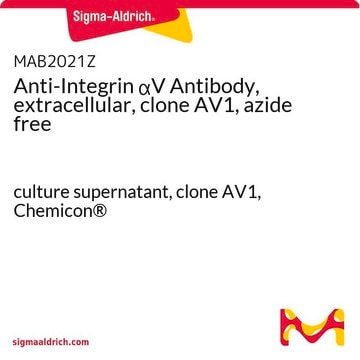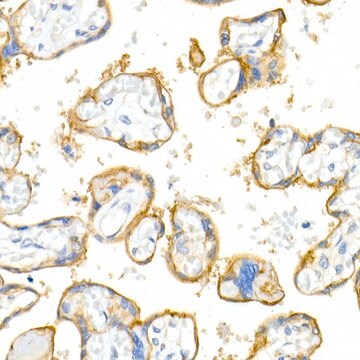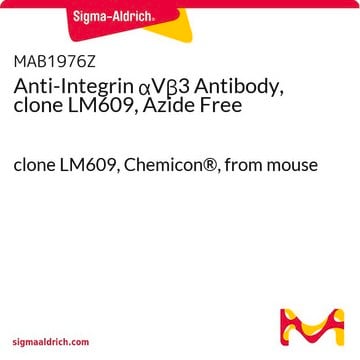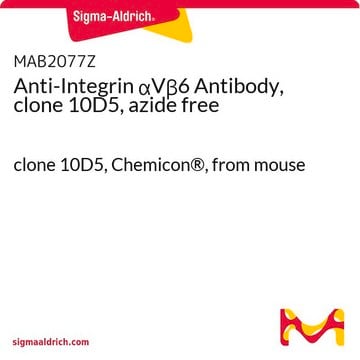AB1930
Anti-Integrin alphaV Antibody, CT, Intracellular
serum, Chemicon®
Sinônimo(s):
CD51
About This Item
Produtos recomendados
fonte biológica
rabbit
Nível de qualidade
forma do anticorpo
serum
tipo de produto de anticorpo
primary antibodies
clone
polyclonal
reatividade de espécies
chicken, hamster, horse, goat, pig, equine, mouse, human, sheep
reatividade da espécie (prevista por homologia)
rat
fabricante/nome comercial
Chemicon®
técnica(s)
ELISA: suitable
immunohistochemistry: suitable
immunoprecipitation (IP): suitable
radioimmunoassay: suitable
western blot: suitable
nº de adesão NCBI
nº de adesão UniProt
Condições de expedição
wet ice
modificação pós-traducional do alvo
unmodified
Informações sobre genes
human ... ITGAV(3685)
Descrição geral
Especificidade
Imunogênio
Aplicação
A 1:1,000 dilution of a previous lot was used in ELISA/RIA.
Immunoprecipitation:
5 μL of a previous lot of this antibody is sufficient to precipitate alphaV/beta1 from 5x106 cells.
Immunohistochemistry:
1:1000 dilution from a previous lot was used in immunohistochemistry. (Suggested for use an acetone fixed tissue only.)
Western blot: 1:5000.
The antibody recognizes a single band at approximately 150 kDa when denatured, but not reduced (Hirsch, 1994). Under reducing conditions this antibody recognizes two major bands of 25 and 27 kDa and, to a lesser extent, the full length 150 kDa band.
Optimal working dilutions must be determined by end user.
Cell Structure
Integrins
Qualidade
Western Blot Analysis: 1:500 dilution of this lot detected INTEGRIN AV light chain on 10 μg of C6 lysates.
Descrição-alvo
forma física
Armazenamento e estabilidade
Handling Recommendations:
Upon receipt, and prior to removing the cap, centrifuge the vial and gently mix the solution. Aliquot into microcentrifuge tubes and store at -20°C. Avoid repeated freeze/thaw cycles, which may damage IgG and affect product performance.
Nota de análise
HT-29 colon carcinoma cells
C6 lysates.
Outras notas
Informações legais
Exoneração de responsabilidade
Not finding the right product?
Try our Ferramenta de seleção de produtos.
recomendado
Código de classe de armazenamento
10 - Combustible liquids
Classe de risco de água (WGK)
WGK 1
Certificados de análise (COA)
Busque Certificados de análise (COA) digitando o Número do Lote do produto. Os números de lote e remessa podem ser encontrados no rótulo de um produto após a palavra “Lot” ou “Batch”.
Já possui este produto?
Encontre a documentação dos produtos que você adquiriu recentemente na biblioteca de documentos.
Nossa equipe de cientistas tem experiência em todas as áreas de pesquisa, incluindo Life Sciences, ciência de materiais, síntese química, cromatografia, química analítica e muitas outras.
Entre em contato com a assistência técnica








